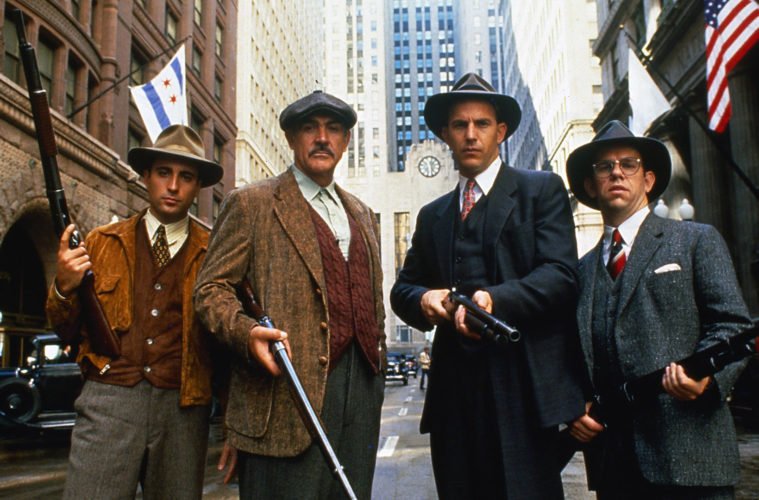
Prohibition’s legacy will always be a period of nearly unprecedented crime. What began as an experiment meant to cure the social and moral ills of a beleaguered nation turned into a reason for the worst of human nature to run wild in the streets. Deception, corruption, violence, and vice ruled the day. As with any such moment in history, certain figures became elevated to the level of myth, and totems from the time became cultural touchstones that would endure for ages. Al Capone. Elliot Ness. Tommy guns. Fedoras. Each of these brings up a specific idea in the mind of the populace and can, by itself, set the imagination on fire.
Who better, then, to create the definitive modern tale of the Prohibition Era than the director who has turned so many other people and items into pop culture totems? Brian De Palma has spun gold out of the hay that is Carrie White at prom, Tony Montana with an assault rifle, and Tom Cruise dangling on a wire. He revels in taking raw elements and turning them into the kind of set pieces and moments that become cultural shorthand. To see him work with elements that had, by that point, already been made into icons is thrilling, because unlike others, who would use those symbols to coast, De Palma makes them his own.
In a story that couldn’t be more perfectly aligned to De Palma’s interests, we see Treasury Officer Elliot Ness (Kevin Costner) attempt to battle Chicago’s bootleg liquor industry. This city is rotten to its core and everyone seems to be on the take. Al Capone (Robert De Niro) runs his business with ruthless efficiency and a violent temper. To make any progress in his crusade against the crime and corruption, Ness has to collect a rag-tag group of misfits and turn them into a crack team of barrel-busters.
De Palma’s greatest asset as a director is his ability to take any story and bend it to his particular will. One can see this particular skill most clearly in the way he takes a script by one of Hollywood’s most recognizable writers, David Mamet, and somehow makes it pure De Palma. Even David Fincher in The Social Network felt like a co-author with Aaron Sorkin, and Mamet is the only screenwriter with more eponymous-isms than Sorkin. Yet, somehow, the director overwhelms the scribe’s trademark dialogue and fits his characters into a stylized world that is now and always will be singularly De Palma’s.
The clearest example of this is the phenomenal and much-discussed shoot-out on the steps of the train station. Cribbing as only a master can from the giants who have come before, De Palma turns the violent confrontation between cops and gangsters into an homage to Battleship Potemkin. In doing so, and in couching the scene within a film of such brilliance, De Palma actually becomes this sequence’s new owner, to the point that most people who parody or pay homage to the “pram rolling down steps” idea nowadays probably believe themselves to be aping The Untouchables.
Even an auteur director is a collaborator with the artists around him, though, and in that way The Untouchables stands as De Palma’s most fully realized collaboration. Every member of its cast shines, from Andy Garcia as the young hothead to Charles Martin Smith as the nebbish accountant. Of course, the foremost among these actors is Sean Connery, who received his only Oscar for his role as the veteran beat cop who gives one of the most famous pieces of advice in motion picture history when he tells Ness, “They pull a knife, you pull a gun. He sends one of yours to the hospital, you send one of his to the morgue.” Those words, of course, were written by David Mamet, and through the accolades given to that performance and the way that those words have entered and taken root in the popular consciousness, we most perfectly see the value and the skill of De Palma as a director.
It is easy now to think of Brian De Palma as a fairly fringe director, someone who creates small, shocking films that drip with style but somehow lack the necessary components to reach popular culture. The Untouchables stands as a testament to when De Palma was at the height of his popular powers and could meld various elements perfectly with his own distinct style to create something that would appeal to everyone — not because of a mundanity, but due to its very specific aesthetic and craft. For a brief moment, we were all on board for exactly what De Palma was doing, and the history of cinema is richer for this.
Continue reading our career-spanning retrospective, The Summer of De Palma, below.


